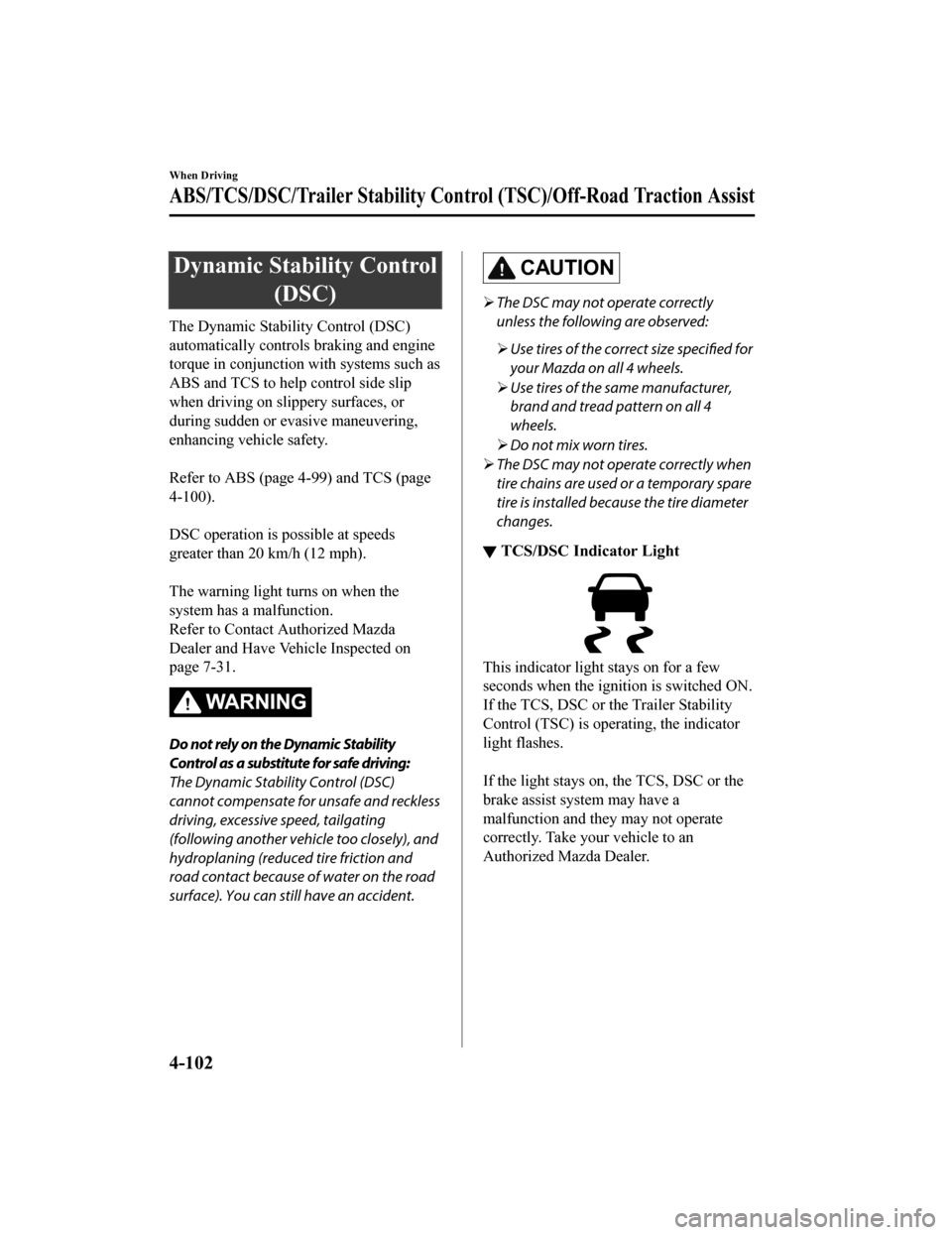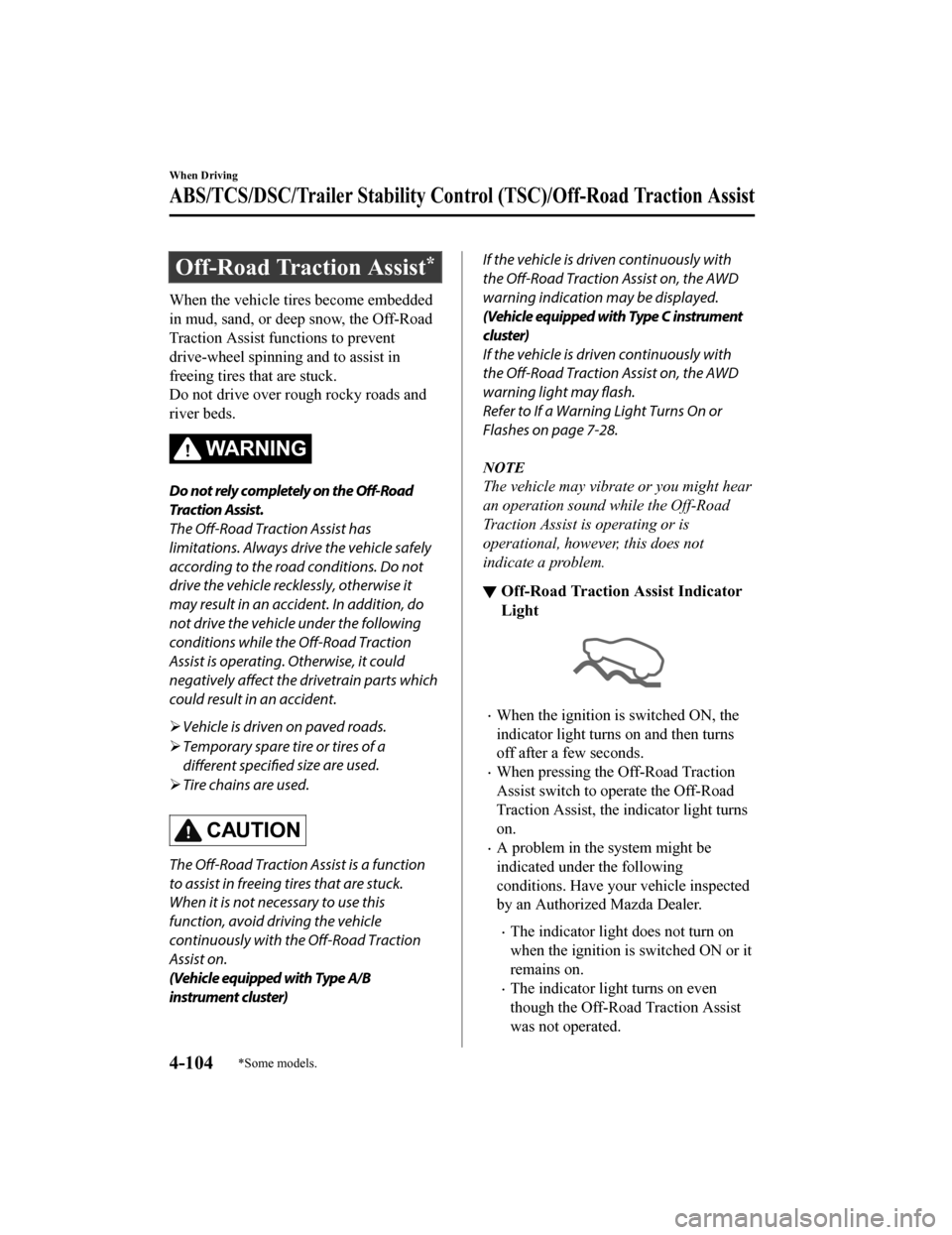warning light MAZDA MODEL CX-9 2020 (in English) Repair Manual
[x] Cancel search | Manufacturer: MAZDA, Model Year: 2020, Model line: MODEL CX-9, Model: MAZDA MODEL CX-9 2020Pages: 706
Page 268 of 706

Dynamic Stability Control(DSC)
The Dynamic Stability Control (DSC)
automatically controls braking and engine
torque in conjunction with systems such as
ABS and TCS to help control side slip
when driving on slippery surfaces, or
during sudden or evasive maneuvering,
enhancing vehicle safety.
Refer to ABS (page 4-99) and TCS (page
4-100).
DSC operation is possible at speeds
greater than 20 km/h (12 mph).
The warning light turns on when the
system has a malfunction.
Refer to Contact Authorized Mazda
Dealer and Have Vehicle Inspected on
page 7-31.
WA R N I N G
Do not rely on the Dynamic Stability
Control as a substitute for safe driving:
The Dynamic Stability Control (DSC)
cannot compensate for unsafe and reckless
driving, excessive speed, tailgating
(following another vehicle too closely), and
hydroplaning (reduced tire friction and
road contact because of water on the road
surface). You can still have an accident.
CAUTION
 The DSC may not operate correctly
unless the following are observed:
 Use tires of the correct size specified for
your Mazda on all 4 wheels.
 Use tires of the same manufacturer,
brand and tread pattern on all 4
wheels.
 Do not mix worn tires.
 The DSC may not operate correctly when
tire chains are used or a temporary spare
tire is installed because the tire diameter
changes.
â–¼ TCS/DSC Indicator Light
This indicator light stays on for a few
seconds when the ignition is switched ON.
If the TCS, DSC or the Trailer Stability
Control (TSC) is operating, the indicator
light flashes.
If the light stays on, the TCS, DSC or the
brake assist system may have a
malfunction and they may not operate
correctly. Take your vehicle to an
Authorized Mazda Dealer.
When Driving
ABS/TCS/DSC/Trailer Stability Cont
rol (TSC)/Off-Road Traction Assist
4-102
CX-9_8HT8-EA-19I_Edition2_old 2019-9-24 13:14:55
Page 270 of 706

Off-Road Traction Assist*
When the vehicle tires become embedded
in mud, sand, or deep snow, the Off-Road
Traction Assist functions to prevent
drive-wheel spinning and to assist in
freeing tires that are stuck.
Do not drive over rough rocky roads and
river beds.
WA R N I N G
Do not rely completely on the Off-Road
Traction Assist.
The Off-Road Traction Assist has
limitations. Always drive the vehicle safely
according to the road conditions. Do not
drive the vehicle recklessly, otherwise it
may result in an accident. In addition, do
not drive the vehicle under the following
conditions while the Off-Road Traction
Assist is operating. Otherwise, it could
negatively affect the drivetrain parts which
could result in an accident.
Vehicle is driven on paved roads.
 Temporary spare tire or tires of a
different
specified size are used.
 Tire chains are used.
CAUTION
The Off-Road Traction Assist is a function
to assist in freeing tires that are stuck.
When it is not necessary to use this
function, avoid driving the vehicle
continuously with the Off-Road Traction
Assist on.
(Vehicle equipped with Type A/B
instrument cluster)
If the vehicle is driven continuously with
the Off-Road Traction Assist on, the AWD
warning indication may be displayed.
(Vehicle equipped with Type C instrument
cluster)
If the vehicle is driven continuously with
the Off-Road Traction Assist on, the AWD
warning light may flash.
Refer to If a Warning Light Turns On or
Flashes on page 7-28.
NOTE
The vehicle may vibrate or you might hear
an operation sound while the Off-Road
Traction Assist is operating or is
operational, however, this does not
indicate a problem.
â–¼ Off-Road Traction Assist Indicator
Light
ï‚·When the ignition is switched ON, the
indicator light turns
on and then turns
off after a few seconds.
ï‚·When pressing the Off-Road Traction
Assist switch to operate the Off-Road
Traction Assist, the indicator light turns
on.
ï‚·A problem in the system might be
indicated under the following
conditions. Have your vehicle inspected
by an Authorized Mazda Dealer.
ï‚·The indicator light does not turn on
when the ignition is switched ON or it
remains on.
ï‚·The indicator light turns on even
though the Off-Road Traction Assist
was not operated.
When Driving
ABS/TCS/DSC/Trailer Stability Cont rol (TSC)/Off-Road Traction Assist
4-104*Some models.
CX-9_8HT8-EA-19I_Edition2_old 2019-9-24 13:14:55
Page 279 of 706

Power Steering
ï‚·Power steering is only operable when
the engine is running. If the engine is off
or if the power steering system is
inoperable, you can still steer, but it
requires more physical effort.
If the steering feels stiffer than usual
during normal driving or the steering
vibrates, consult an Authorized Mazda
Dealer.
ï‚·The warning indication/warning light
notifies the driver of system
abnormalities and operation conditions.
In addition, the buzzer may also activate
depending on the system abnormality or
operation condition.
Refer to Stop Vehicle in Safe Place
Immediately on page 7-28.
Refer to Power Steering Warning
Buzzer on page 7-50.
CAUTION
Never hold the steering wheel to the
extreme left or right for more than 5
seconds with the engine running. This
could damage the power steering system.
When Driving
Power Steering
4-113
CX-9_8HT8-EA-19I_Edition2_old2019-9-24 13:14:55
Page 280 of 706

i-ACTIVSENSE*
i-ACTIVSENSE is a collective term covering a series of advanced safety and driver support
systems which make use of a Forward Sensing Camera (FSC) and radar sensors. These
systems consist of active safety and pre-crash safety systems.
These systems are designed to assist the driver in safer driving by reducing the load on the
driver and helping to avert collisions or reduce their severity. However, because each system
has its limitations, always drive carefully and do not rely solely on the systems.
â–¼Active Safety Technology
Active Safety Technology supports safer driving by helping the driver to recognize potential
hazards and avert accidents.
Driver awareness support systems
Nighttime visibility
Adaptive Fron
t Lighting System (AFS)................................................................... page 4-117
High Beam Control System (HBC).......................................................................... page 4-118
Left/right side and rear side detection
Lane Departure Warning System (LDWS)..... ......................................................... page 4-156
Blind Spot Monitoring (BSM)......................... ........................................................ page 4-121
Road sign recognition
Traffic Sign Recognition System (TSR).................................................................. page 4-127
Inter-vehicle distance recognition
Distance Recognition Su pport System (DRSS)....................................................... page 4-133
Rear obstruction detection when leaving a parking space
Rear Cross Traffic Alert (RCTA).............................................................................page 4-137
Full-surround recognition
360°View Monitor................................................................................................... page 4-175
Driver support systems
Inter-vehicle distance
Mazda Radar Cruise Control with Stop & Go function (MRCC with Stop & Go
function)................................................................................................................... pag e 4-141
Lane departure
Lane-keep Assist System (LAS)................... ........................................................... page 4-156
When Driving
i-ACTIVSENSE
4-114*Some models.
CX-9_8HT8-EA-19I_Edition2_old 2019-9-24 13:14:55
Page 281 of 706

â–¼Pre-Crash Safety Technology
Pre-crash safety technology is designed to assi
st the driver in averting collisions or reduce
their severity in situations where they cannot be avoided.
Collision damage reduction in low vehicle speed range
Forward driving
Smart City Brake Support (SCBS).......................................................................... page 4-170
Advanced Smart City Brake Support (Advan ced SCBS)........................................ page 4-167
Collision damage reduction in medium/high speed range
Smart Brake Support (SBS)..................................................................................... page 4-173
â–¼ Camera and Sensors
Forward Sensing Camera (FSC)
The Forward Sensing Camera (FSC) detects la
ne indications and recognizes headlights,
taillights and city lights during nighttime driv ing. In addition, it also detects the vehicle
ahead, pedestrians, or obstructions. The following systems also use the Forward Sensing
Camera (FSC).
ï‚·High Beam Control system (HBC)
ï‚·Lane-keep Assist System (LAS) & Lane Departure Warning System (LDWS)
ï‚·Traffic Sign Recognition System (TSR)
ï‚·Mazda Radar Cruise Control wi th Stop & Go function (MRCC with Stop & Go function)
ï‚·Advanced Smart City Brake Support (Advanced SCBS)
ï‚·Smart City Brake Support (SCBS)
ï‚·Smart Brake Support (SBS)
The Forward Sensing Camera (FSC) is installed at the top of the windshield near the
rearview mirror.
Refer to Forward Sensing Camera (FSC) on page 4-201.
Radar sensor (front)
The radar sensor (front) functions by detecti ng the radio waves reflected off a vehicle ahead
sent from the radar sensor. The following systems also use the radar sensor (front).
ï‚·Mazda Radar Cruise Control with Stop & Go function (MRCC with Stop & Go function)
ï‚·Distance Recognition Support System (DRSS)
ï‚·Smart Brake Support (SBS)
The radar sensor (front) is mount ed behind the radiator grille.
Refer to Radar Sensor (Front) on page 4-206.
When Driving
i-ACTIVSENSE
4-115
CX-9_8HT8-EA-19I_Edition2_old 2019-9-24 13:14:55
Page 283 of 706

Adaptive Front Lighting System (AFS)*
The adaptive front lighting system (AFS) automatically adjusts the headlight beams to the
left or right in conjunction with the operation of the steering wheel after the headlights have
been turned on.
A system malfunction or operation conditions are indicated by a warning.
Refer to Contact Authorized Mazda Dealer and Have Vehicle Inspected on page 7-31.
NOTE
The Adaptive Front Lighting System (AFS) func tion can be switched to operable/inoperable
using the personalization function.
Refer to Personalization Features on page 9-9.
When Driving
i-ACTIVSENSE
*Some models.4-117
CX-9_8HT8-EA-19I_Edition2_old 2019-9-24 13:14:55
Page 284 of 706

High Beam Control System (HBC)*
The HBC determines the conditions in front of the vehicle using the Forward Sensing
Camera (FSC) while driving in darkness to automatically switch the headlights between
high and low beams.
Refer to Forward Sensing Camera (FSC) on page 4-201.
While driving the vehicle at a speed of about 30 km/h (19 mph) or more, the headlights are
switched to high beams when there are no vehicles ahead or approaching in the opposite
direction.
The system switches the headlights to low beams when one of the following occurs:
ï‚·The system detects a vehicle or the headlights/lights of a vehicle approaching in the
opposite direction.
ï‚·The vehicle is driven on roads lined with st reetlamps or on roads in well-lit cities and
towns.
ï‚·The vehicle is driven at less than about 20 km/h (12 mph).
Forward Sensing
Camera (FSC)
The recognition distance of the
Forward Sensing Camera (FSC)
varies according to the
surrounding conditions.
The warning light turns on when
the system has a malfunction.
Refer to Contact Authorized Mazda Dealer and Have Vehicle Inspected on page 7-31.
CAUTION
 Do not adjust the vehicle height, modify th e headlight units, or remove the camera,
otherwise the system will not operate normally.
 Do not rely excessively on the HBC and drive the vehicle while paying sufficient attention to
safety. Switch the headlights between the high beams and low beams manually if
necessary.
When Driving
i-ACTIVSENSE
4-118*Some models.
CX-9_8HT8-EA-19I_Edition2_old 2019-9-24 13:14:55
Page 287 of 706

Blind Spot Monitoring (BSM)*
The BSM is designed to assist the driver in checking the area to the rear of the vehicle on
both sides during lane changes by notifying the driver of the presence of vehicles
approaching from the rear in an adjacent lane.
The BSM detects vehicles approaching from the rear while traveling in the forward
direction at a speed of 10 km/h (6.3 mph) or faster and notifies the driver by turning on the
BSM warning indicator light and displaying the vehicle detection screen.
If the turn signal lever is operated to signal a turn in the direction in which the BSM
warning indicator light is illuminated while the approaching vehicle is detected, the BSM
notifies the driver of possible danger by turnin g on the BSM warning indicator light, and by
activating the warning sound and the warning screen indicator display.
The detection area on this system covers the driving lanes on both sides of the vehicle and
from the rear part of the front doors to about 50 m (164 ft) behind the vehicle.
Detection areas
Your vehicle
WA R N I N G
Always check the surrounding area visually before making an actual lane change:
The system is only designed to assist you in checking for vehicles at your rear when making a
lane change. Due to certain limitations with
the operation of this system, the BSM warning
indicator light, the warning sound and the warning screen indicator display may not activate
or they might be delayed even though a vehicle is in an adjacent driving lane. Always make it
your responsibility as a driver to check the rear.
When Driving
i-ACTIVSENSE
*Some models.4-121
CX-9_8HT8-EA-19I_Edition2_old 2019-9-24 13:14:55
Page 288 of 706

NOTE
ï‚·The BSM will operate when all of the following conditions are met:
ï‚·The ignition is switched ON.
ï‚·The BSM OFF indicator light in the instrument cluster is turned off.
ï‚·The vehicle speed is about 10 km/h (6.3 mph) or faster.
ï‚·The BSM will not operate under the following circumstances.
ï‚·The vehicle speed falls below about 10 km/h (6.3 mph) even though the BSM OFF
switch indicator light is turned off.
ï‚·The selector lever is shifted to R position and the vehicle is reversing.
ï‚·The turning radius is small (making a sharp turn, turning at intersections).
ï‚·In the following cases, the BSM OFF indicator light turns on and operation of the system
is stopped. If the BSM OFF indicator light re mains illuminated, have the vehicle inspected
at an Authorized Mazda Dealer as soon as possible.
ï‚·Some problem with the system including the BSM warning indicator lights is detected.
ï‚·A large deviation in the installation position of a radar sensor (rear) on the vehicle has
occurred.
ï‚·There is a large accumulation of snow or ice on the rear bumper near a radar sensor
(rear). Remove any snow, ice or mud on the rear bumper.
ï‚·Driving on snow-covered roads for long periods.
ï‚·The temperature near the radar sensors (rear) becomes extremely hot due to driving for
long periods on slopes during the summer.
ï‚·The battery voltage has decreased.
ï‚·Under the following conditions, the radar sensors (rear) cannot detect target objects or it
may be difficult to detect them.
ï‚·A vehicle is in the detection area at the rear in an adjacent driving lane but it does not
approach. The BSM determines the condition based on radar detection data.
ï‚·A vehicle is traveling alongside your vehicle at nearly the same speed for an extended
period of time.
ï‚·Vehicles approaching in the opposite direction.
ï‚·A vehicle in an adjacent driving lane is attempting to pass your vehicle.
ï‚·A vehicle is in an adjacent lane on a road with extremely wide driving lanes. The
detection area of the radar sensors (rear) is set at the road width of expressways.
ï‚·In the following case, the flashing of the BS M warning indicator light, and the activation
of the warning sound and the warning screen indicator display may not occur or they may
be delayed.
ï‚·A vehicle makes a lane change from a driving lane 2 lanes over to an adjacent lane.
ï‚·Driving on steep slopes.
ï‚·Crossing the summit of a hill or mountain pass.
When Driving
i-ACTIVSENSE
4-122
CX-9_8HT8-EA-19I_Edition2_old 2019-9-24 13:14:55
Page 289 of 706

ï‚·When there is a difference in the height between your driving lane and the adjacent
lane.
ï‚·Directly after the BSM system becomes operable by changing the setting.
ï‚·If the road width is extremely narrow, vehicles 2 lanes over may be detected. The detection
area of the radar sensors (rear) is set according to the road width of expressways.
ï‚·The BSM warning indicator light may turn on and the vehicle detection screen may be
displayed in the display in reaction to stationary objects (guardrails, tunnels, sidewalls,
and parked vehicles) on the road or the roadside.
Objects such as guardrails and concrete walls
running alongside the vehicle. Places where the width between guardrails or
walls on each side of the vehicle narrows.
The walls at the entrance and exits of tunnels,
turnouts.
ï‚·A BSM warning indicator light may flash or the warning beep and the warning screen
indicator display may be activated several times when making a turn at a city
intersection.
ï‚·Turn off the BSM while pulling a trailer or wh
ile an accessory such as a bicycle carrier is
installed to the rear of the vehicle. Otherwise, the radar’s radio waves will be blocked
causing the system to not operate normally.
ï‚·In the following cases, it may be difficult to view the illumination/flashing of the BSM
warning indicator lights equipped on the door mirrors.
ï‚·Snow or ice is adhering to the door mirrors.
ï‚·The front door glass is fogged or covered in snow, frost or dirt.
ï‚·The radar sensors (rear) of the BSM may be regulated under the radio wave related laws
of the country where the vehicle is driven. The sensors in this system are approved for use
in the U.S.A. (including territories), Canada, and Mexico. If a vehicle with a BSM is
driven in a country other than the U.S.A., Canada, or Mexico, authorization from the
country where the vehicle is driven might be required.
ï‚·The system switches to the Rear Cross Traffic Alert function when the selector lever is
shifted to the reverse (R) position.
Refer to Rear Cross Traffic Alert (RCTA) on page 4-137.
When Driving
i-ACTIVSENSE
4-123
CX-9_8HT8-EA-19I_Edition2_old 2019-9-24 13:14:55